painting within limits
Posted: January 26, 2019 Filed under: eARTh | Tags: Aesthetics, Arte Povera, Arts, arts research, Cornwall, Earth, earth pigments, eco art, ecopsychology, Environmental art, indigenous culture, painting, Pigment, Visual arts 1 Commentnew paintings from Cornwall – early 2019
For many years I have exclusively used colours from the earth in my paintings, gathering and processing all the pigments myself. Each location offers a unique palette and quality of colour to work with as well as a deeper understanding of that place.
To some it may seem as if creativity is being limited. “How can I paint the sky or the trees?” are frequent questions when running workshops. Working with earth pigments has changed the way I work and my understanding of painting in many ways. It has enriched my perception of colour and the ‘material’ of colour. Black is no longer “an absence of light”. For me it allows a specific expression of place orientated, of course, by my own relationship to being there.
The paintings here respond to the nature of earth colours and experiences in West Cornwall…
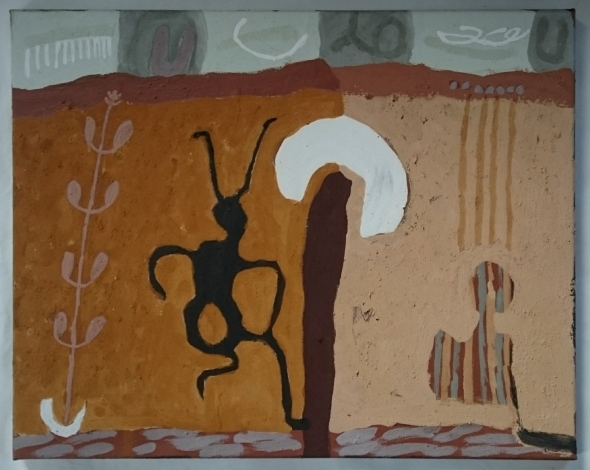 distance what we have become (Cornish earth pigments on canvas; 60x40cm) © p ward 2019
distance what we have become (Cornish earth pigments on canvas; 60x40cm) © p ward 2019
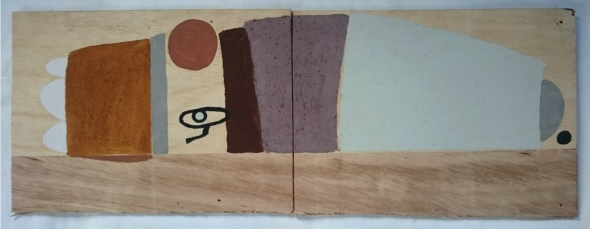 big red wolf moon that I did not see (Cornish earth pigments on board; 76x28cm) © p ward 2019
big red wolf moon that I did not see (Cornish earth pigments on board; 76x28cm) © p ward 2019
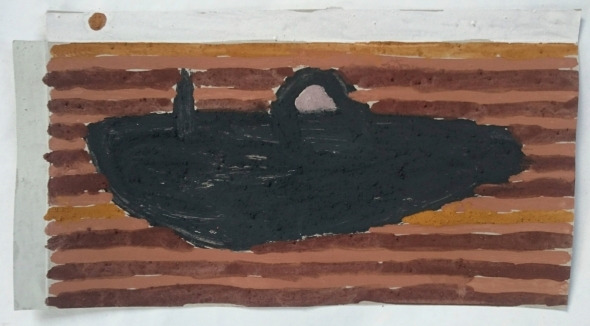 to run aground an island (Cornish earth pigments on card; 27x15cm) © p ward 2019
to run aground an island (Cornish earth pigments on card; 27x15cm) © p ward 2019
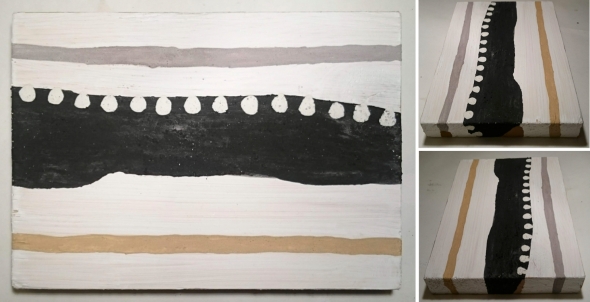 estuary (Cornish earth pigments on wood; 20×14.5x2cm) © p ward 2019
estuary (Cornish earth pigments on wood; 20×14.5x2cm) © p ward 2019
 untitled I, II, III (Cornish earth pigments on board; 25x26cm; 25x28cm; 25x26cm) © p ward 2019
untitled I, II, III (Cornish earth pigments on board; 25x26cm; 25x28cm; 25x26cm) © p ward 2019
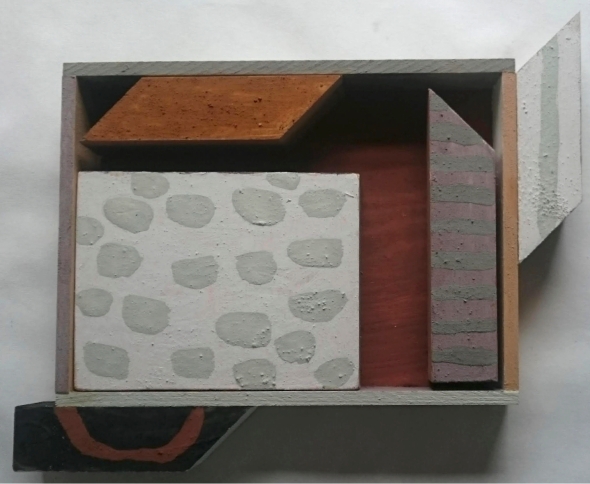 offcuts homestead (Cornish earth pigments on wood; 29x24x3cm) © p ward 2019
offcuts homestead (Cornish earth pigments on wood; 29x24x3cm) © p ward 2019
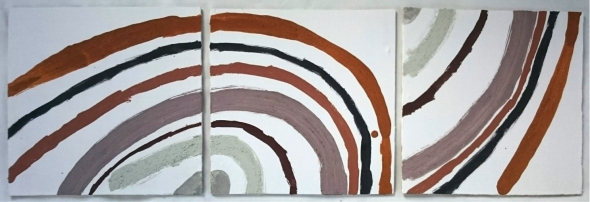 at fault (Cornish earth pigments on board; 80x26cm) © p ward 2019
at fault (Cornish earth pigments on board; 80x26cm) © p ward 2019
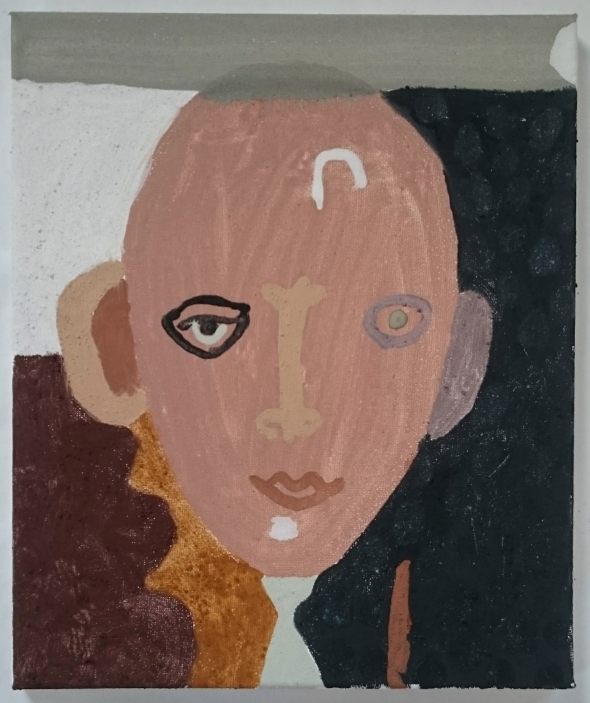 fairy queen (Cornish earth pigments on canvas; 25x30cm) © p ward 2019
fairy queen (Cornish earth pigments on canvas; 25x30cm) © p ward 2019
© P Ward 2019
coming of age
Posted: July 5, 2017 Filed under: eARTh | Tags: Aesthetics, Arte Povera, arts research, Bideford Black, Earth, earth pigments, eco art, ecopsychology, Environmental art, Feeling, Meditation, North Devon, painting, Pigment, Visual arts Leave a commentmore new paintings (and thoughts about my practice), summer 2017
“I am no longer sure of what I am doing. But then, quite simply, I am painting. I am putting together objects from materials that I gather locally, here in North Devon. Materials that are significant to me. That have stories to tell. That connect me to this place and to my being. The objects created are celebrations of this life. They are explorations. Simple, intuitive journeys of making in the here and now…” (Artist statement, summer 2017)
 burrows (earth pigments on board) © p ward 2017
burrows (earth pigments on board) © p ward 2017
At the tender age of fifty I am finding it harder to define exactly what my artwork is about. In the past I might talk about the power of art as an agent of change but no longer feel this is my main inspiration. Its power is now subtler both within my life and in the world. No longer do I work obsessively, searching for meaning and understanding – indeed my life does not allow it – but see it as a means to share my sense of wonder with the world, through both the materials I use and the approach I take to making. It is a space for myself, to come to terms with life, to find balance and peace. For whatever reason art and making has become a central aspect of my being, like a good friend. Whether this has a positive value to society as a whole I am not sure but in society, art is always there, in whatever form, quietly infiltrating the rigid constructs of our existence.
 sea wall (earth pigments on board) © p ward 2017
sea wall (earth pigments on board) © p ward 2017
However comfortable I may personally feel with my artistic practice I still feel a need (and this is where an issue/dilemma arises) to verbally justify and explain it to others, both for the sake of art historical context and as an aesthetic anchor within the art market – people seem to like to know what they’re buying into. To say that I enjoy mystery or the process seems simply not enough. Intuition is very important to me – to make, to work with the materials, until a piece ‘feels’ ‘right’ is essential to the process.
 particular I-IV (earth pigments on board) © p ward 2017
particular I-IV (earth pigments on board) © p ward 2017
To approach work not necessarily from any literal or narrative starting point, beyond the constraints of my chosen materials, but simply as an act of trust or sense of belief in the creative process and in my simple intent – to share my sense of wonder and beauty in existence. I have been slowly building my own language of marks and forms in response to the process of gathering and making paint with earth pigments. As such I feel the work is a celebration of our connection to place, and the physical matter of place, and our evolving relationship with them.
 offcuts in an offcut frame XI – factual (earth pigments on wood) © p ward 2017
offcuts in an offcut frame XI – factual (earth pigments on wood) © p ward 2017
The titles I enjoy as a poetic response to the work, often with reference to personal experience, and as a means for others to access the work.
 drawing on obscurity XII – surprise party (earth pigments on board) © p ward 2017
drawing on obscurity XII – surprise party (earth pigments on board) © p ward 2017
Politically and spiritually the work I do is significant through its lack of ‘control’, through its trust in simple processes and its respectful empathy with natural materials – it is made in mindful contradiction of the current worldview of human superiority, of ‘power over’, in denial of our supposed ability to know what is the right thing to do – we have already endangered existence through our arrogance, maybe it is time to step back a little before we create more problems. To live simply, in peace with ourselves, with others and all of existence is maybe all we can do…
 standing by the river, beneath the trees, watching rain fall (earth pigments on board) © p ward 2017
standing by the river, beneath the trees, watching rain fall (earth pigments on board) © p ward 2017
 drawing on obscurity XII – if I move slowly enough will I become a tortoise? (earth pigments on driftwood) © p ward 2017
drawing on obscurity XII – if I move slowly enough will I become a tortoise? (earth pigments on driftwood) © p ward 2017
 drawing on obscurity XIII – infiltration (earth pigments on board) © p ward 2017
drawing on obscurity XIII – infiltration (earth pigments on board) © p ward 2017
 tree (earth pigments on board) © p ward 2017
tree (earth pigments on board) © p ward 2017
Infiltration is the process by which water on the ground surface enters the soil. Infiltration rate in soil science is a measure of the rate at which soil is able to absorb rainfall or irrigation. It is measured in inches per hour or millimetres per hour.[i]
© P Ward 2017
________________________________________
[i] https://en.wikipedia.org/wiki/Infiltration_(hydrology)
please accept my resignation 131016
Posted: October 13, 2016 Filed under: activ8, eARTh, educ8, Uncategorized | Tags: Aesthetics, Arte Povera, arts research, Bideford Black, child art, collaboration, Communication, cycling, dance, Devon, Earth, earth pigments, eco art, Ecology, ecopsychology, Environmental art, Feeling, Interdisciplinarity, Nature, North Devon, North Devon Coast, Pigment, Visual arts 4 Comments
some things I have seen, done and made that have made me think, feel and smile over the last few months…
“Reading true literature [Nan Shepherd] reflected, ‘it’s as though you are standing experiencing and suddenly the work is there, bursting out of its own ripeness . . . life has exploded, sticky and rich and smelling oh so good. And . . . that makes the ordinary world magical – that reverberates/illuminates.’ ” taken from Landmarks by Robert Macfarlane.
 folded paper; little family; special gifts; friendship (earth pigments on canvas) © p ward 2016
folded paper; little family; special gifts; friendship (earth pigments on canvas) © p ward 2016
 wooden tray full of found things © eARTh 2016
wooden tray full of found things © eARTh 2016
 ‘the exmoor beast’!?, exmoor zoological gardens © p ward 2016
‘the exmoor beast’!?, exmoor zoological gardens © p ward 2016
 drawing a line, coast to coast with skedge 13916 © eARTh 2016
drawing a line, coast to coast with skedge 13916 © eARTh 2016
 learning to draw I © p ward 2016
learning to draw I © p ward 2016
 learning to draw II, III, IV © eARTh 2016
learning to draw II, III, IV © eARTh 2016
 towan beach, roseland peninsula; bottallack mines, st just, cornwall © p ward 2016
towan beach, roseland peninsula; bottallack mines, st just, cornwall © p ward 2016
 west somerset railway; bicclescombe park shed, ilfracombe © eARTh 2016
west somerset railway; bicclescombe park shed, ilfracombe © eARTh 2016
 painted palette (earth pigments on wood) © eARTh 2016
painted palette (earth pigments on wood) © eARTh 2016
 offcuts in an offcut frame – palette; mask (earth pigments on wood) © p ward 2016
offcuts in an offcut frame – palette; mask (earth pigments on wood) © p ward 2016
 figure; offcuts in an offcut frame – VIII (earth pigments on wood); building blocks © p ward 2016
figure; offcuts in an offcut frame – VIII (earth pigments on wood); building blocks © p ward 2016
with special thanks to francesca, noah, agnes, family and friends for your love, support and companionship 🙂
© p ward/eARTh 2016
home: research, research and inspiration – early 2016 update
Posted: June 15, 2016 Filed under: A BUNDLE OF STICKS, activ8, BIOSPHERic, eARTh, Uncategorized | Tags: art and science, Arte Povera, arts research, collaboration, Devon, Earth, earth pigments, East Devon, eco art, Ecology, ecopsychology, Environmental art, Feeling, indigenous culture, Interdisciplinarity, North Devon, North Devon Coast, Pigment, poetry, Soil Culture 2 Commentswater, air and earth
sticks and stones
and, somewhere, fire
.
as the year unfolds
to a new life
within us
.
and you grow
and hold us rapt
in your emphatic personality
.
we deliberate upon Nature
each delicate
and deafening response
.
there is red and black and grey and green
dirt to some
riches to others
.
grinding away
what is left
to leave
.
more
and more
and more
.
we play
and learn
we play together
.
knees
teeth
home
.
 home: County Clare, Ireland © p ward 2016
home: County Clare, Ireland © p ward 2016
The year began with family and friends in a rainswept County Clare, Ireland, my home for 10 years. Many of the places I wanted to revisit and share were beneath meters of water. Things, of course, had changed for better and worse but the spirit of the land still shone through.
 home: Lake Vyrnwy, Powys, Wales © p ward 2106
home: Lake Vyrnwy, Powys, Wales © p ward 2106
Then more mountains and lakes, family and friends, as my brother’s path shifts to the Welsh borders, an area I have not visited before but will visit again. This time snow, ice, fog and sunshine accompanied my journey. Lake Vyrnwy reservoir submerged a Welsh village to supply England with water.
 home: Ilfracombe, winter 2016 © p ward 2016
home: Ilfracombe, winter 2016 © p ward 2016
And at ‘home’ the winter lashes the coastline, reshaping and reforming. Ilfracombe was originally named after King Alfred and was gifted to two of his sons as a sheltered harbour on the western approaches to his kingdom. Before then an iron-age hill fort overlooked the natural harbour from, what is now, Hillsborough nature reserve. This part of the North Devon coast is formed predominantly from Devonian slates, sandstones and shales and boasts some of the highest sea cliffs in England. We have a new studio here that we hope will provide a base for our creative endeavours and space for others to enjoy.
 home: Barnstaple Bay and Hele, North Devon © p ward 2016
home: Barnstaple Bay and Hele, North Devon © p ward 2016
 home: Holdstone Down, Combe Martin, North Devon © p ward 2016
home: Holdstone Down, Combe Martin, North Devon © p ward 2016
 let’s talk dirt! (White Moose Gallery, CCANW, Heritage Lottery Fund, Bideford Pottery, IGI Ltd, Roger Cockram)
let’s talk dirt! (White Moose Gallery, CCANW, Heritage Lottery Fund, Bideford Pottery, IGI Ltd, Roger Cockram)
In May, as part of the CCANW Soil Culture project, I led a walk and talk with the White Moose Gallery and supported by the Heritage Lottery Fund, to celebrate North Devon’s relationship with its earth resources. “Let’s Walk and Talk Dirt!” involved local potters, Harry Juniper and Roger Cockram, geologists Chris Cornford and Andrew Green, and soil scientist David Hogan to present some different perspectives about our local resources. Participants really enjoyed the interdisciplinary nature of the events but were frustrated by the lack of time to explore the subject matter in more depth. We are now working towards a ‘summer school’ to further explore North Devon’s potteries, pigments, rocks and soils.
 Sidmouth, East Devon © p ward 2106
Sidmouth, East Devon © p ward 2106
 Jacob’s Ladder beach, Sidmouth, East Devon © p ward 2016
Jacob’s Ladder beach, Sidmouth, East Devon © p ward 2016
The Thelma Hulbert Gallery, Honiton, East Devon invited me in May, to run painting with earth workshops to accompany their ongoing Soil Culture exhibitions. The first workshop introduced the ideas to a small group of partially sighted children from the WESC Foundation, providing a space for us to enjoy the more than visual experience of the process and materials. I was also excited to be exploring a new area of the country, encouraging me to find new pigments and learn about their geology and history. The second workshop, for artists, included an invigorating morning field trip to Jacob’s Ladder beach in Sidmouth to gather small quantities of the iron-rich red and green mudstones, and whatever else took our fancy, followed by an afternoon of furious experimentation grinding and binding a selection of pigments with a variety of mediums. It was great to meet some new faces in such a lively and friendly gallery.
 home: Wessex – Branscombe beach, East Devon; Hardy country (chalk and flint) © p ward 2016
home: Wessex – Branscombe beach, East Devon; Hardy country (chalk and flint) © p ward 2016
Something that did surprise me was the presence of chalk in the landscape of East Devon. Having been raised in Portsmouth I am familiar with the chalk and flint of the South Downs and Isle of Wight but wasn’t aware of it so far west along the coast. The sedimentary Cretaceous beds at Beer, that I saw from Branscombe beach during a day of research, lie above Upper Greensand that then rests on the more familiar Mercian Triassic red mudstones of South Devon. Apparently there is an ‘unconformity’ here in that the interceding Jurassic layer is missing, the area being land during that era. The nodules of flint and chert present in the Chalk and Upper Greensand that make up the beaches are also apparent in the local architecture creating further similarities to the South Downs and other Chalk areas across Europe.
One such region, that I also feel an affinity with through my ancestry and boyhood cycling adventures, is the Wessex Downs. The ancient country of Wessex encompassed Hampshire, west to the Cornish borders, and Wiltshire, Dorset, Devon and Somerset. In more recent times its character and characters have formed the backdrop for the literary works of Thomas Hardy. I was recently contacted by a research fellow from Exeter University to collaborate in a project to explore the value to health and well being of arts-based environmental workshops. His previous research looked at the work of Thomas Hardy in relation to the Wessex landscape. We are now waiting to see if our initial funding application has been successful before embarking on a major AHRC project around a similar theme. It has been fascinating working with a complete stranger towards a shared goal.
 Hele community group sculpture proposal sketches © eARTh 2016
Hele community group sculpture proposal sketches © eARTh 2016
Meanwhile, closer to home again we have been working with the local community towards re-landscaping an unsightly patch of ground behind the bus shelter in our village. It was good to be invited, to meet some more of our neighbours, to learn about the history of the village and to think how to we might alter such a space to celebrate the area. It was recently discovered that the area is owned (rather than it being public space) which has put the project back somewhat!?
 sketches in wood and stone © p ward 2016
sketches in wood and stone © p ward 2016
And back in the studio I have been enjoying putting together some new work (see previous post) using old offcuts of wood, old pots of paint and some new pigments. After 9 months I finally feel like I am settling in, enjoying the space and making something new, as well as finding time for my other interests and beautiful family. With a new arrival imminent we’ll be working hard to keep it up…
 jacob’s ladder, earth pigments on canvas © p ward 2016
jacob’s ladder, earth pigments on canvas © p ward 2016
 corn mill close, masonry paint on painted board © p ward 2016
corn mill close, masonry paint on painted board © p ward 2016
 offcuts – sketch in wood © p ward 2016
offcuts – sketch in wood © p ward 2016
© P Ward 2016
back to basics
Posted: January 14, 2016 Filed under: eARTh | Tags: Arts, arts research, Bideford Black, Devon, Earth, earth pigments, eco art, Environmental art, North Devon, Pigment, Visual arts 1 Comment5 small earth paintings
Beaten by both the need for storage space for my work and, hopefully, a more commercially viable product I have resorted, and returned, to making a number of small earth pigment paintings on paper.
Originally I wanted to explore the layering and removal of water-based paint, similar to my past use of watercolour, using earth pigments. This worked well for one piece but I soon strayed back to the more recent pattern approach that working with earth pigments has inspired.
My method, as in the past, allows the pigments, the colours, textures and forms, to suggest and reveal the form of the finished piece. It can often take a while for the painting to evolve, employing a variety of accumulated intuitive, mark making and aesthetic decisions and skills to move forward. Working in this way is always fascinating, offering outcomes beyond my present understandings.
 back to basics 1 – earth pigment dreaming (earth pigments on watercolour paper) © p ward 2015
back to basics 1 – earth pigment dreaming (earth pigments on watercolour paper) © p ward 2015
 back to basics 2 – black form dreaming (earth pigments on watercolour paper) © p ward 2015
back to basics 2 – black form dreaming (earth pigments on watercolour paper) © p ward 2015
 back to basics 3 – joyful exchanges (earth pigments on watercolour paper) © p ward 2015
back to basics 3 – joyful exchanges (earth pigments on watercolour paper) © p ward 2015
 back to basics 4 – unctuous burnt umber (earth pigments on watercolour paper) © p ward 2015
back to basics 4 – unctuous burnt umber (earth pigments on watercolour paper) © p ward 2015
 back to basics 5 – grey and cream earth (earth pigments on watercolour paper) © p ward 2015
back to basics 5 – grey and cream earth (earth pigments on watercolour paper) © p ward 2015
Each painting measures 21x21cm and is on 300gsm watercolour paper. The pigments, a selection of six hand ground, locally gathered colours from North Devon, have been simply mixed with water and then fixed with pastel fixative. I am now looking forward to making more simple paintings on paper of different sizes to develop this approach.
The original paintings are available for sale online or later in the year at our new studio space at Hele Corn Mill, near Ilfracombe in North Devon.
For more information please contact me at earth.northdevon@gmail.com
© P Ward 2016
Soil Culture: The Publication
Posted: January 13, 2016 Filed under: activ8, eARTh | Tags: art and science, arts research, Bideford Black, Earth, earth pigments, eco art, Ecology, ecopsychology, Environmental art, Interdisciplinarity, Pigment, Soil, Soil Culture Leave a commentThe Soil Culture project led by CCANW and RANE will be drawing to a close soon with its final exhibition at Peninsula Arts in Plymouth from 16th January to 19th March 2016[i]. The project as has been documented in a 120-page publication with essays by prominent soil scientists and soil artists, along with illustrated accounts of residencies and other activities enjoyed during the 3-years.
 soil culture – the publication (cover), images © p ward 2015
soil culture – the publication (cover), images © p ward 2015
My involvement in the project began when I met CCANW director Clive Adams in 2009. I presented him with six small glass pots of ground earth pigments from North Devon. He suggested I meet soil artist Dr Daro Montag at Falmouth University who was just starting an MA Art & Environment Course, which I subsequently attended.
 north devon landscape (ground earth pigments) © p ward 2008
north devon landscape (ground earth pigments) © p ward 2008
I was invited to join the Soil Culture project development team in 2011. My contribution has also involved workshops, exhibitions and some of the imagery used to promote and support it. I was recently asked to write a short essay for the publication and retake a series of photographs of ground and raw earth pigments to be used for the cover and chapter/section headings…
 raw and ground earth pigments for soil culture publication © p ward 2015
raw and ground earth pigments for soil culture publication © p ward 2015
The publication is available from http://www.ccanw.co.uk/ at a price of £15 per copy.
© p ward 2016
[i] Peninsula Arts Gallery, Roland Levinsky Building, Plymouth University, PL4 8AA. Open Monday-Friday 10am-5pm, Saturday 11am-4pm
eARTh has MOVED…
Posted: October 30, 2015 Filed under: A BUNDLE OF STICKS, activ8, BIOSPHERic, eARTh | Tags: art and science, Arte Povera, arts research, Bideford Black, collaboration, Devon, Earth, earth pigments, eco art, Ecology, ecopsychology, Environmental art, indigenous culture, Interdisciplinarity, North Devon, North Devon Coast, Pigment, Visual arts 1 CommentMIDWINTER OPEN STUDIO
Saturday 28th and Sunday 29th November, 1100-1600
After an exciting first year, including a great exhibition at the White Moose Gallery, a number of successful workshops and OPEN STUDIOS and participation in other international projects, eARTh has relocated to a smaller, more rural space at Hele Corn Mill where we (myself and partner Francesca Owen) will be continuing our work with local earth pigments and plant dyes.
 hele corn mill and eARTh studio © f owen 2015
hele corn mill and eARTh studio © f owen 2015
Hele Corn Mill dates from 1525 and is a unique working watermill in North Devon. Located just 300m from stunning Hele Bay beach just east of Ilfracombe, a visit to the mill makes a perfect family visit. Opposite the mill is the Miller’s Wife Tearoom, where you can relax and enjoy a traditional cream tea or a slice of one of many delicious cakes, which are homemade every day. For directions, parking and opening times please visit www.helecornmill.com.
You are warmly invited to a pre-Christmas opening – a chat, some nibbles, a glass of wine and some art. If you cannot make the opening please feel free to visit anytime. eARTh will be open on a regular basis along with workshops, exhibitions and events throughout the year and is looking forward to seeing you soon.
For more information please visit www.earthnorthdevon.wix.com/arts
© P Ward 2015
painting together workshops at the white moose
Posted: August 15, 2015 Filed under: BIOSPHERic, eARTh, educ8 | Tags: Arte Povera, arts research, Bideford Black, collaboration, Devon, Earth, earth pigments, eco art, Ecology, ecopsychology, Environmental art, indigenous culture, North Devon, North Devon Coast, Pigment, Soil, Soil Culture, Visual arts Leave a commentTo accompany our[i] recent exhibition, painting together, at the White Moose Gallery[ii] in Barnstaple, we offered three workshops to explore the possibilities of creative collaboration through painting with local earth pigments. The first two workshops consisted of morning visits to prominent pigment sites followed by afternoons making paint and painting together on a shared canvas in the gallery. The third workshop was spent entirely in the gallery and looked closer at paint making techniques before using rocks and soils gathered in the previous outings to work with.
North Devon has an extremely rich geology – a combination of Devonian, Carboniferous, Perma-Triassic and more recent glacial deposits – that has shaped the way we have and still relate to the environment. Glacial clays have provided excellent material for local potteries. Copper, iron, sliver and tin were mined on Exmoor. Culm grasslands have offered fertile grazing for beef, dairy and other livestock. And different earth pigments have been extracted for both industrial and artistic applications. Bideford Black (and anthracite) was mined across the region until 1969, while raw umber was extracted from locations around Combe Martin[iii]. But wherever we go there is always an incredibly varied spectrum of earth colours to be used, representing and celebrating sense of place however we choose to express ourselves.
Sharing a surface to work on – in this case a previously prepared canvas – was found to be a fun, if sometimes frustrating, but rewarding and liberating experience. Sharing the whole experience – gathering pigments, making paint, sharing lunch and conversation, working on a communal surface and finally reflecting on the day – offered new ways of working beyond the more often isolated practice we enjoy. It’s not for all but can help shift our practice as artists into new areas, seeing how others work, observing our own methods, habits and expectations from a different perspective and raising interesting questions of ownership, value and public perception towards communal ways of working.
fremington quay eARTh walk 27615
 fremington quay eARTh walk 1 © eARTh and K McEndoo 2015
fremington quay eARTh walk 1 © eARTh and K McEndoo 2015
A first impression of Fremington Quay may be that of a fairly non-descript quay on the bend of a muddy estuary. However, when we look a bit deeper a rich history is evident. It was once one of the largest ports in the southwest, exporting iron, wool and clay, amongst other local products, around the world and importing coal and lime from South Wales. Until recently the Quay was a major railway siding, replaced now by the Tarka Trail cycle path extending from Barnstaple to the Ball Clay quarries at Meeth and Peters Marland south of Torrington. Its history is excellently displayed in the newly refurbished museum at the equally excellent café in the old station building.
The Quay sits broadly on the meeting of the Devonian (450 million years ago) and Carboniferous (350 million years ago) geological eras, a weakness in strata marked by the River Taw’s meandering intersection. The underlying carboniferous shales, slates and mudstones of the Crackington Beds, extend west to Hartland Point, and are capped on the southern banks of the estuary by glacial deposits from the Flandrian Ice Age 40,000 years ago. All this creates ideal conditions for the amazing array of pigments to be found along the low cliffs beyond the large disused stone limekiln west of the quay. A few miles inland Fremington clay pits provided fine red clay until 2013, helping establish and maintain the local potteries in Barnstaple and Bideford. The clays were laid down as sediments in glacial lakes and riverbeds. The folds, cracks and twists in the sedimentary carboniferous rocks allow for oxidization of minerals, offering an exquisite range of colours and textures. Some have said that in other countries the site would be considered a national heritage site. For now however it is protected as a Site of Special Scientific Interest.
I first came across the site when walking my dog many years ago, noticing the fantastic colours and rocks. However, it wasn’t until I started seriously researching earth pigments that I actually touched the rocks and found the colour. I have since visited with eminent geologists form the Ussher Society and Devonshire Association to learn more about it – although to be honest I wonder if I have not become just more confused, each ‘expert’ offering a different theory of the areas formation, age and make-up.
 fremington quay eARTh walk 2 © eARTh and K McEndoo 2015
fremington quay eARTh walk 2 © eARTh and K McEndoo 2015
For the painting together workshop the participants were bowled over by both the area’s history and geology and the amazing array of colours available. The painting we made is, I think evidence, of the lively experience and the richness of the site. It was subsequently hung in the Create Centre in Bristol as part of the Soil Culture exhibition.
 fremington quay eARTh walk, earth pigments on canvas © eARTh, K McEndoo, S Levy 2015
fremington quay eARTh walk, earth pigments on canvas © eARTh, K McEndoo, S Levy 2015
Greencliff eARTh walk 15715
Bideford Black has become popular among artists recently, after numerous projects focusing on its local significance and artistic potential. This workshop was therefore, not surprisingly, well attended with 10 participants and thankfully the weather was glorious. While the Bideford Black deposits exposed at Greencliff were the main attraction, there is a good range of other usable pigments easily accessible from the attendant sandstones and clays – white, grey, orange and pink rocks and clays were gathered, along with other beach detritus, and taken back to be enjoyed in the afternoon painting session.
 Greencliff eARTh walk workshop 1 © eARTh 2015
Greencliff eARTh walk workshop 1 © eARTh 2015
 Greencliff eARTh walk workshop 2 © eARTh 2015
Greencliff eARTh walk workshop 2 © eARTh 2015
There being more people made for a quite chaotic and crowded painting together experience, with two smaller canvasses being provided to take a specific place in the White Moose show. Limitations and parameters are an important aspect of any creative process and these were discussed at length within the context of the day’s workshop. Participants ranged from experienced artists and students to designers and other interested parties. Again the results and insights gained were an exciting reflection on the site, its history ad geology, the materials and the day’s events.
 greencliff eARTh walk I & II, earth pigments on canvas © eARTh 2015
greencliff eARTh walk I & II, earth pigments on canvas © eARTh 2015
painting together, White Moose 25715
After a brief overview of previous workshops and introduction to the materials, the final workshop experimented with various methods of paint making including using egg tempera, gum Arabic and PVA glue as binders. As a theme we focused on water and the sea. The rocks, clays and soils we were using were predominantly sedimentary, being laid down thousands and hundreds of millions of years ago under the ocean, by rivers, in lakes or by ice in glacial times. This is an idea that Francesca and myself are both interested to investigate and participants were happy to indulge us.
 painting together workshop © eARTh 2015
painting together workshop © eARTh 2015
The group shared their own experiences and relationships with water, and more specifically the sea, and continued to use this as a focus for mark making, imagery and discussion throughout the process. We thought of immersion, of healing, of play, of floating and sinking, of mysterious and murky depths and of a power wild and untamable. We painted creatures and waves. We blew bubbles. We wallowed in mud. One of the challenges was to paint the sea without the colour blue! The paintings success for me lay in its obscurity, its vagueness and shifting focus. Were we beneath the sea or floating in primordial swamp, part of it or separate? Its hard to tell, but we had a great day making it.
 the sea, earth pigments on canvas © eARTh 2015
the sea, earth pigments on canvas © eARTh 2015
Many thanks to Karen and Stella and to all those who took part in the workshops, to all who visited and enjoyed the exhibition, to all who contributed to the work and especially to the White Moose for hosting the exhibition. Unfortunately, we didn’t sell any work and had to cancel the ‘in conversation’ event through lack of interest but maybe that is a sign of the times or of a prevailing attitude in North Devon towards more contemporary/conceptual art forms but also an interesting reflection on people’s response to communal work. But whatever each time we entered the space we felt extremely proud and pleased with the show, with the work we had done together and the experience we had offered all who took part. We have thoroughly enjoyed it and hope to take the show further afield in due course.
…
But for now, all good things must come to an end…
 un-painting the moose © eARTh 2015
un-painting the moose © eARTh 2015
© P Ward 2015
[i] http://earthnorthdevon.wix.com/arts
[ii] http://www.whitemoose.co.uk/site/
[iii] According to local sources “no paint box was complete without Berrynarbour umber.” The pigment was mined until the 1790s and ground with ochre from East Down before being sent to London to be included in Reeves paint boxes. I have taken umber from the River Umber that runs through Combe Martin but as yet I have not located the quarries where it was mined.
Tales of the Riverbank: BLACK & WHITE
Posted: June 21, 2015 Filed under: activ8, BIOSPHERic, eARTh | Tags: arts research, Bideford Black, collaboration, Devon, Earth, earth pigments, eco art, Ecology, ecopsychology, Environmental art, North Devon, North Devon Coast, Pigment, Soil Culture, Visual arts Leave a commentMany thanks to those who joined us for a splendid morning in the company of ex-Bideford Black miner Ron Pither, as we slowly walked the length of Mines Road in East-the-Water recalling days-gone-by, and for an expressive afternoon painting together with Bideford Black and white Peters Marland Ball clay onto a shared canvas at the old Bideford Art School on the Quay, as part of the first Tales of the Riverbank event organized by Bideford Bay Creatives. The events – workshops, walks and talks – spread throughout the summer, explore the natural and social history surrounding the River Torridge in North Devon.
 a walk down memory lane, mines road © p ward 2015
a walk down memory lane, mines road © p ward 2015
As we walked, Ron’s vivid and joyful recollections of his time as a miner and young man growing up in East-the-Water the 1950’s, laced with other historical details by myself, brought greater depth and colour to a seemingly non-descript lane on the outskirts of town. Mines Road, as the name suggests, used to lead to the Chapel Park pigment mines that finally closed in 1969 – there is little physical evidence left today to reveal its not too distant past. I had met Ron as part of the Story of Bideford Black project for the Burton Art Gallery in 2013 and he jumped at the opportunity to share more of his memories today.
 painting together – BLACK & WHITE, a work in progress © p ward 2015
painting together – BLACK & WHITE, a work in progress © p ward 2015
After lunch the small, but select, party of artists and others interested in local history worked together to create a painting that somehow responded to the memories shared during the walk and to the specific local materials provided. Decisions were made as a group at critical stages of the process regarding the definition of parameters and as to how the painting should progress, revealing individual and collective ideas about the creative process in general and the specific nature of the materials involved. The painting produced will be exhibited as part of Soil Culture at create in Bristol from July 8th.
 painting together – BLACK & WHITE, the gallery © p ward 2015
painting together – BLACK & WHITE, the gallery © p ward 2015
Many thanks also to Learn Devon for providing such a great space to conduct the workshop.
Further Links
- For more information about further Tales of the Riverbank events please visit http://www.bbcdevon.org/2015/05/11/book-for-tales-of-the-riverbank/
- For more information about Bideford Black please visit http://bidefordblack.blogspot.co.uk/
- For more information about painting together workshops please visit http://www.whitemoose.co.uk/site/events-at-white-moose-gallery-north-devon/
- For more information about Soil Culture at create please visit http://www.ccanw.co.uk/create.htm
P Ward 2015
painting with earth (again) … a new start
Posted: June 18, 2015 Filed under: activ8, BIOSPHERic, eARTh | Tags: Arte Povera, Bideford Black, collaboration, Devon, Earth, earth pigments, eco art, Environmental art, indigenous culture, North Devon, Pigment, Soil Culture, Visual arts 2 Commentsart trail ART TREK open studios 2015
Prompted and encouraged by our recent investigation at eARTh into natural paint binders with Clare Thomas and the opportunity to show some new work during two recent open studio events, I have been doing some painting…
 vernal equinox 1 (51x31cm; earth pigments with gum arabic and rabbit skin glue on canvas) © p ward 2015
vernal equinox 1 (51x31cm; earth pigments with gum arabic and rabbit skin glue on canvas) © p ward 2015
 vernal equinox 2 (60x50cm; earth pigments with gum arabic on canvas) © p ward 2015
vernal equinox 2 (60x50cm; earth pigments with gum arabic on canvas) © p ward 2015
 storyteller 3 (50x50cm; earth pigments with gum arabic and rabbit skin glue on canvas) © p ward 2015
storyteller 3 (50x50cm; earth pigments with gum arabic and rabbit skin glue on canvas) © p ward 2015
 crow point triptych (3x60x50cm; earth pigments with gum arabic and rabbit skin glue on canvas) © f owen & p ward 2015
crow point triptych (3x60x50cm; earth pigments with gum arabic and rabbit skin glue on canvas) © f owen & p ward 2015
The different natural binders (gum arabic, rabbit skin glue and damar varnish), new range of colours and larger scale, and inspiration of working closely with another painter, has provided more depth, transparency, fluidity and subtlety in mark-making within my painting and rejuvenated my desire for and understanding of its place within my life. Thank you Clare for your thorough investigation and generous sharing of your discoveries and materials. My own work has continued along its theme of resonance, energy and potential, hopefully offering space for healing and rejuvenation through personal observation and the local assimilation of process, materials and colour. The work is still intuitively aligned to a sense of landscape, connection and place, to nature’s processes and cycles, to magic and the power of intent, meditation and prayer.
 bonk! (250x150cm; earth pigments with rabbit skin glue on canvas) © p ward 2015
bonk! (250x150cm; earth pigments with rabbit skin glue on canvas) © p ward 2015
 i do not love (it is) (78x78cm; earth pigments with gum arabic, damar varnish and rabbit skin glue on canvas) © p ward 2015
i do not love (it is) (78x78cm; earth pigments with gum arabic, damar varnish and rabbit skin glue on canvas) © p ward 2015
 indigo (90x70cm; earth pigments with gum arabic and rabbit skin glue on driftwood board) © p ward 2015
indigo (90x70cm; earth pigments with gum arabic and rabbit skin glue on driftwood board) © p ward 2015
 eARTh open studio © v large 2015
eARTh open studio © v large 2015
The open studio events – Ilfracombe Art Trail 2015 and North Devon Art Trek 2015 – provided an opportunity for free community eARTh painting workshops, further contributions towards Francesca and I’s forthcoming painting together exhibition/project at White Moose Gallery in Barnstaple, and to meet a broad range of people – artists and non-artists alike. Ilfracombe Art Trail, a new and enthusiastically organized local community event including 40 artists in 25 venues throughout the town, brought nearly 150 people through eARTh’s doors in one weekend. While the more established Art Trek, spread across the whole of North Devon for 3 weeks, brought a far smaller number maybe indicating a natural trend towards the ‘local’ within the creative industries. Thank you to all who helped organize both events and to everyone who made time to visit us and contribute to the paintings. The Ilfracombe painting was initially shown at the Landmark Theatre in Ilfracombe before being hung along with a selection of other collaborative and communal works in Barnstaple – see next post.
 full house – community painting at eARTh for ilfracombe art trail 2015 © eARTh 2015
full house – community painting at eARTh for ilfracombe art trail 2015 © eARTh 2015
P Ward 2015



